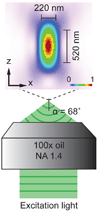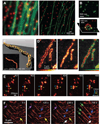Super-resolution fluorescence microscopy
- PMID: 19489737
- PMCID: PMC2835776
- DOI: 10.1146/annurev.biochem.77.061906.092014
Super-resolution fluorescence microscopy
Abstract
Achieving a spatial resolution that is not limited by the diffraction of light, recent developments of super-resolution fluorescence microscopy techniques allow the observation of many biological structures not resolvable in conventional fluorescence microscopy. New advances in these techniques now give them the ability to image three-dimensional (3D) structures, measure interactions by multicolor colocalization, and record dynamic processes in living cells at the nanometer scale. It is anticipated that super-resolution fluorescence microscopy will become a widely used tool for cell and tissue imaging to provide previously unobserved details of biological structures and processes.
Figures





References
-
- Hell SW, Wichmann J. Breaking the diffraction resolution limit by stimulated-emission: stimulated emission- depletion fluorescence microscopy. Opt. Lett. 1994;19:780–782. - PubMed
-
- Klar TA, Hell SW. Subdiffraction resolution in far-field fluorescence microscopy. Opt. Lett. 1999;24:954–956. - PubMed
-
- Hell SW. Far-field optical nanoscopy. Science. 2007;316:1153–1158. - PubMed
Publication types
MeSH terms
Grants and funding
LinkOut - more resources
Full Text Sources
Other Literature Sources

